BTEC HNC Business: Leadership, Management & Operations at Starbucks
VerifiedAdded on 2024/06/21
|39
|6642
|167
Report
AI Summary
This report provides an in-depth analysis of Starbucks' management and operations, focusing on the role of leadership in achieving business objectives. It examines the company's business culture, leadership styles, and management functions, linking them to organizational goals. Various leadership and management theories, such as transformational leadership, transactional leadership, classical management theory, and contingency theory, are applied to understand Starbucks' operational strategies. The report also highlights the significance of operations management, including Six Sigma, TQM, Kaizen Concept, and Queuing theory, in achieving company objectives. Furthermore, it delves into Starbucks' supply chain management, product process, distribution channels, CSR standards, stakeholder management strategies, and approaches to dealing with slow, medium, and fast changes in the business environment. The report emphasizes the importance of stakeholder involvement for innovation and continuous improvement within Starbucks' business operations.
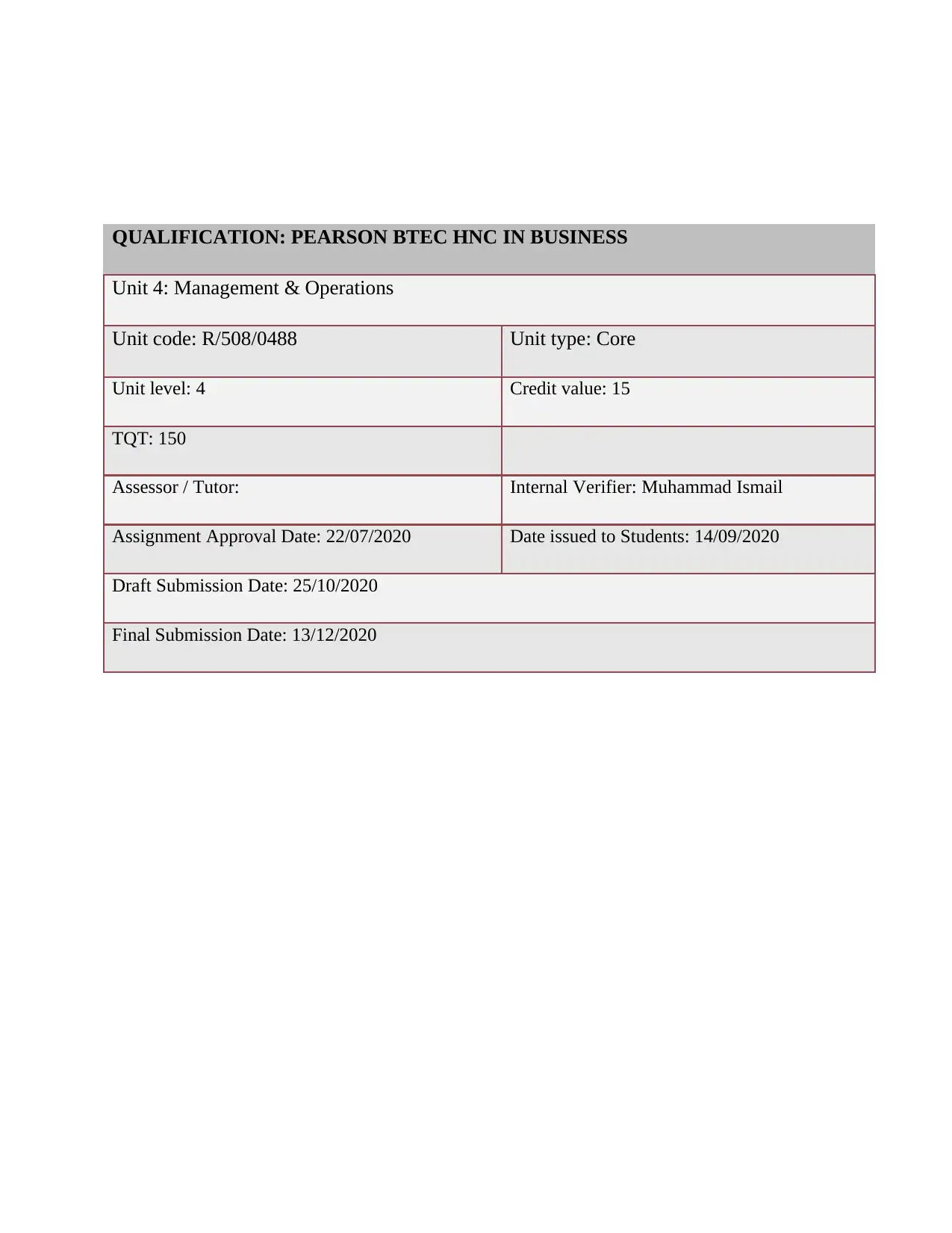
QUALIFICATION: PEARSON BTEC HNC IN BUSINESS
Unit 4: Management & Operations
Unit code: R/508/0488 Unit type: Core
Unit level: 4 Credit value: 15
TQT: 150
Assessor / Tutor: Internal Verifier: Muhammad Ismail
Assignment Approval Date: 22/07/2020 Date issued to Students: 14/09/2020
Draft Submission Date: 25/10/2020
Final Submission Date: 13/12/2020
Unit 4: Management & Operations
Unit code: R/508/0488 Unit type: Core
Unit level: 4 Credit value: 15
TQT: 150
Assessor / Tutor: Internal Verifier: Muhammad Ismail
Assignment Approval Date: 22/07/2020 Date issued to Students: 14/09/2020
Draft Submission Date: 25/10/2020
Final Submission Date: 13/12/2020
Paraphrase This Document
Need a fresh take? Get an instant paraphrase of this document with our AI Paraphraser
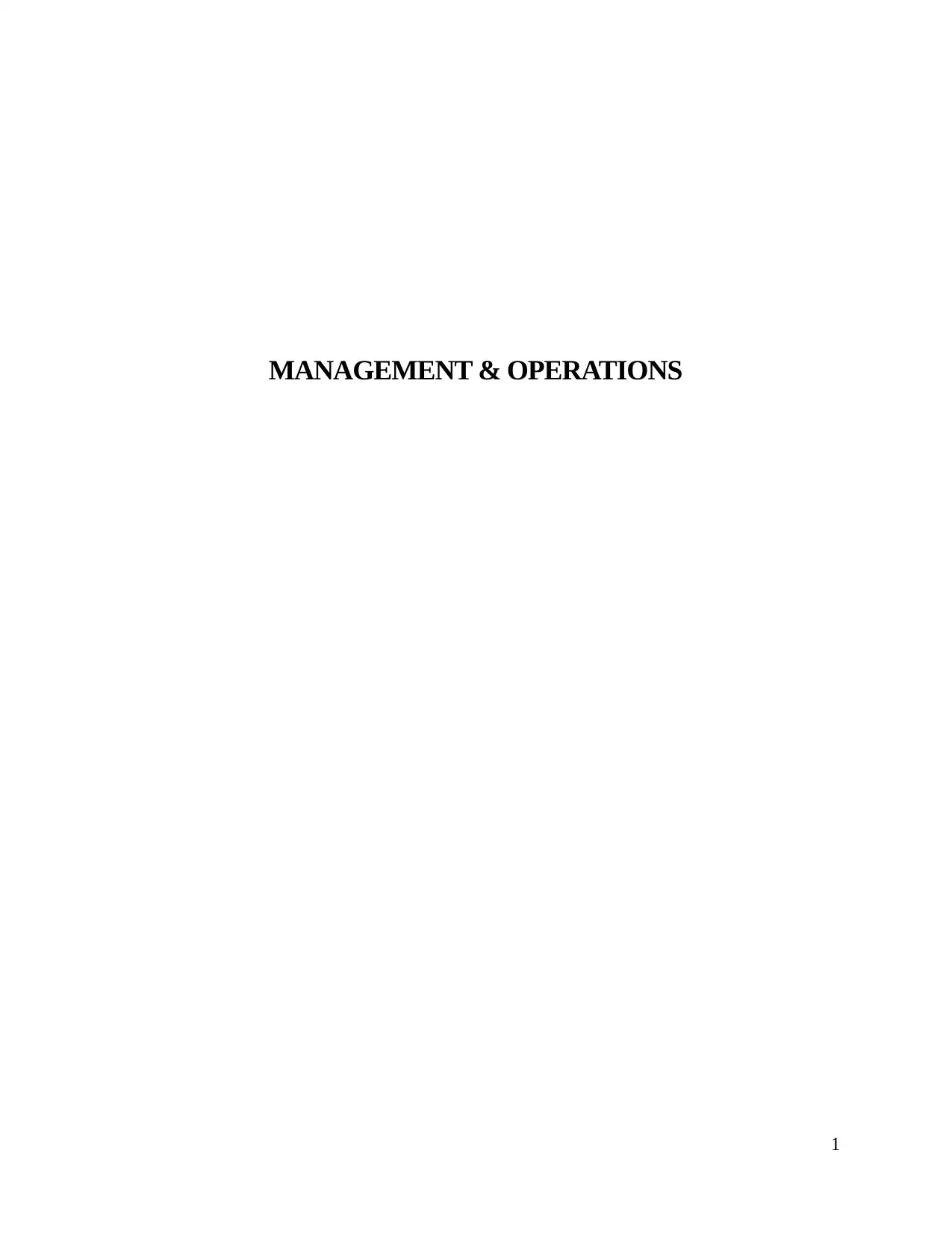
MANAGEMENT & OPERATIONS
1
1
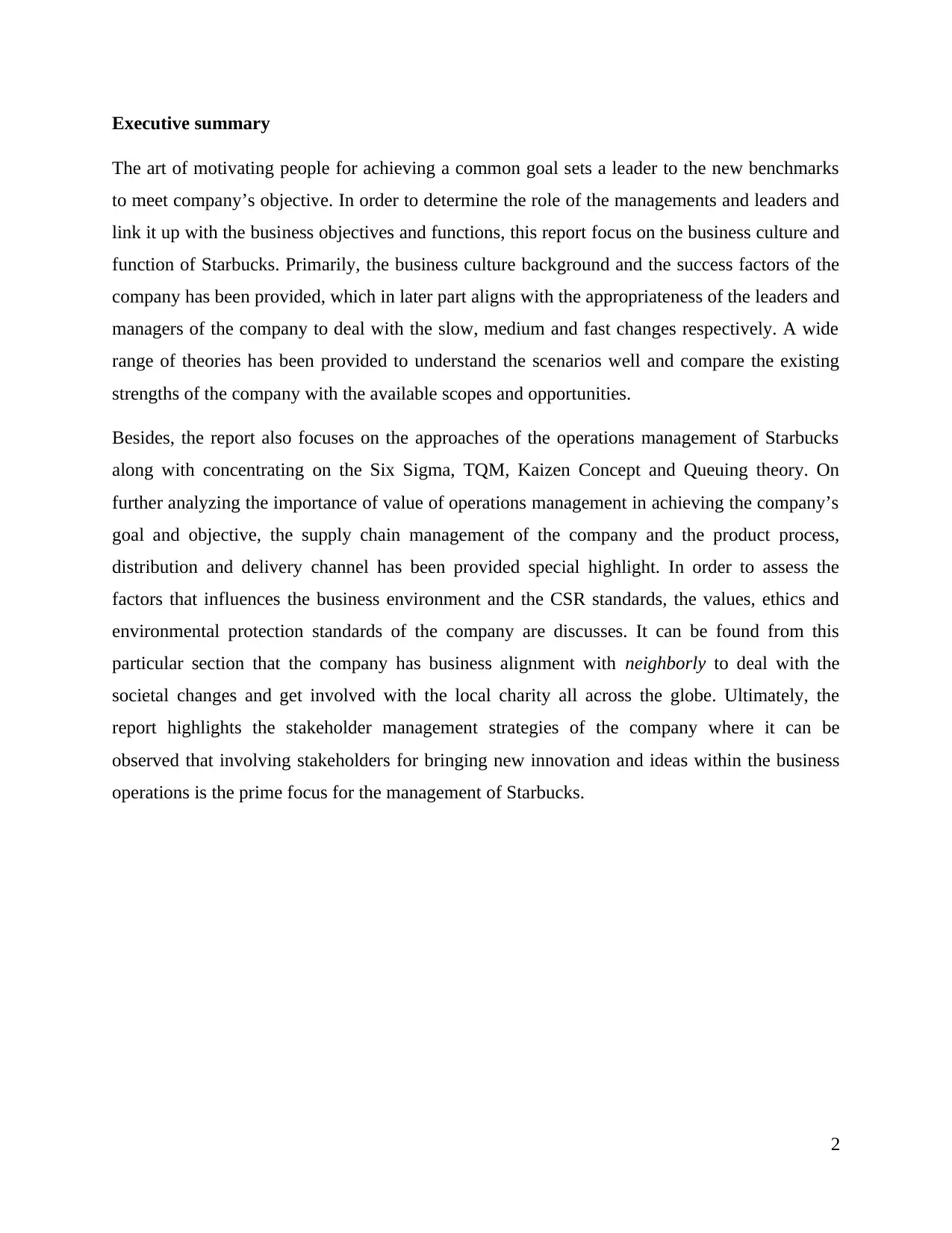
Executive summary
The art of motivating people for achieving a common goal sets a leader to the new benchmarks
to meet company’s objective. In order to determine the role of the managements and leaders and
link it up with the business objectives and functions, this report focus on the business culture and
function of Starbucks. Primarily, the business culture background and the success factors of the
company has been provided, which in later part aligns with the appropriateness of the leaders and
managers of the company to deal with the slow, medium and fast changes respectively. A wide
range of theories has been provided to understand the scenarios well and compare the existing
strengths of the company with the available scopes and opportunities.
Besides, the report also focuses on the approaches of the operations management of Starbucks
along with concentrating on the Six Sigma, TQM, Kaizen Concept and Queuing theory. On
further analyzing the importance of value of operations management in achieving the company’s
goal and objective, the supply chain management of the company and the product process,
distribution and delivery channel has been provided special highlight. In order to assess the
factors that influences the business environment and the CSR standards, the values, ethics and
environmental protection standards of the company are discusses. It can be found from this
particular section that the company has business alignment with neighborly to deal with the
societal changes and get involved with the local charity all across the globe. Ultimately, the
report highlights the stakeholder management strategies of the company where it can be
observed that involving stakeholders for bringing new innovation and ideas within the business
operations is the prime focus for the management of Starbucks.
2
The art of motivating people for achieving a common goal sets a leader to the new benchmarks
to meet company’s objective. In order to determine the role of the managements and leaders and
link it up with the business objectives and functions, this report focus on the business culture and
function of Starbucks. Primarily, the business culture background and the success factors of the
company has been provided, which in later part aligns with the appropriateness of the leaders and
managers of the company to deal with the slow, medium and fast changes respectively. A wide
range of theories has been provided to understand the scenarios well and compare the existing
strengths of the company with the available scopes and opportunities.
Besides, the report also focuses on the approaches of the operations management of Starbucks
along with concentrating on the Six Sigma, TQM, Kaizen Concept and Queuing theory. On
further analyzing the importance of value of operations management in achieving the company’s
goal and objective, the supply chain management of the company and the product process,
distribution and delivery channel has been provided special highlight. In order to assess the
factors that influences the business environment and the CSR standards, the values, ethics and
environmental protection standards of the company are discusses. It can be found from this
particular section that the company has business alignment with neighborly to deal with the
societal changes and get involved with the local charity all across the globe. Ultimately, the
report highlights the stakeholder management strategies of the company where it can be
observed that involving stakeholders for bringing new innovation and ideas within the business
operations is the prime focus for the management of Starbucks.
2
⊘ This is a preview!⊘
Do you want full access?
Subscribe today to unlock all pages.

Trusted by 1+ million students worldwide
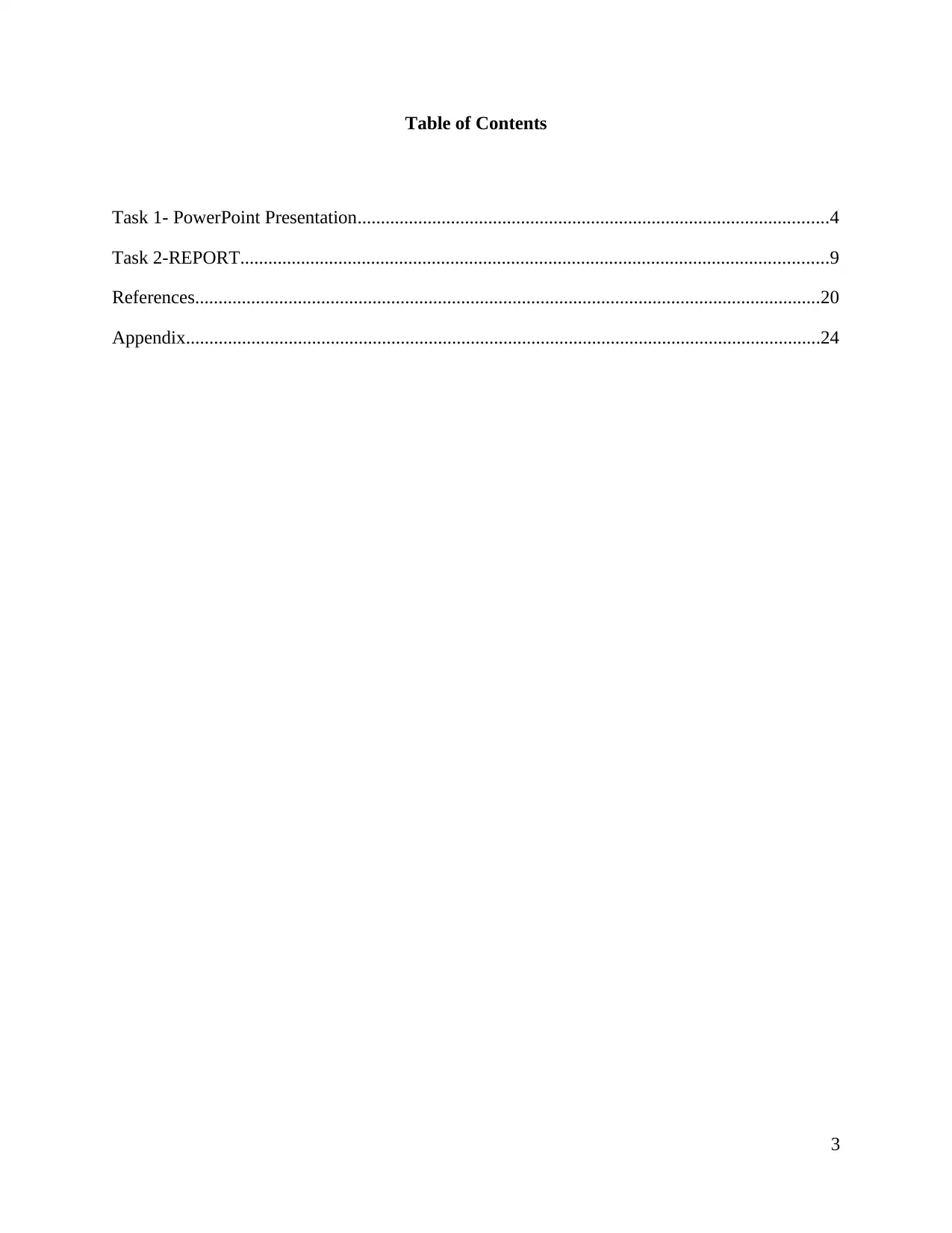
Table of Contents
Task 1- PowerPoint Presentation.....................................................................................................4
Task 2-REPORT..............................................................................................................................9
References......................................................................................................................................20
Appendix........................................................................................................................................24
3
Task 1- PowerPoint Presentation.....................................................................................................4
Task 2-REPORT..............................................................................................................................9
References......................................................................................................................................20
Appendix........................................................................................................................................24
3
Paraphrase This Document
Need a fresh take? Get an instant paraphrase of this document with our AI Paraphraser
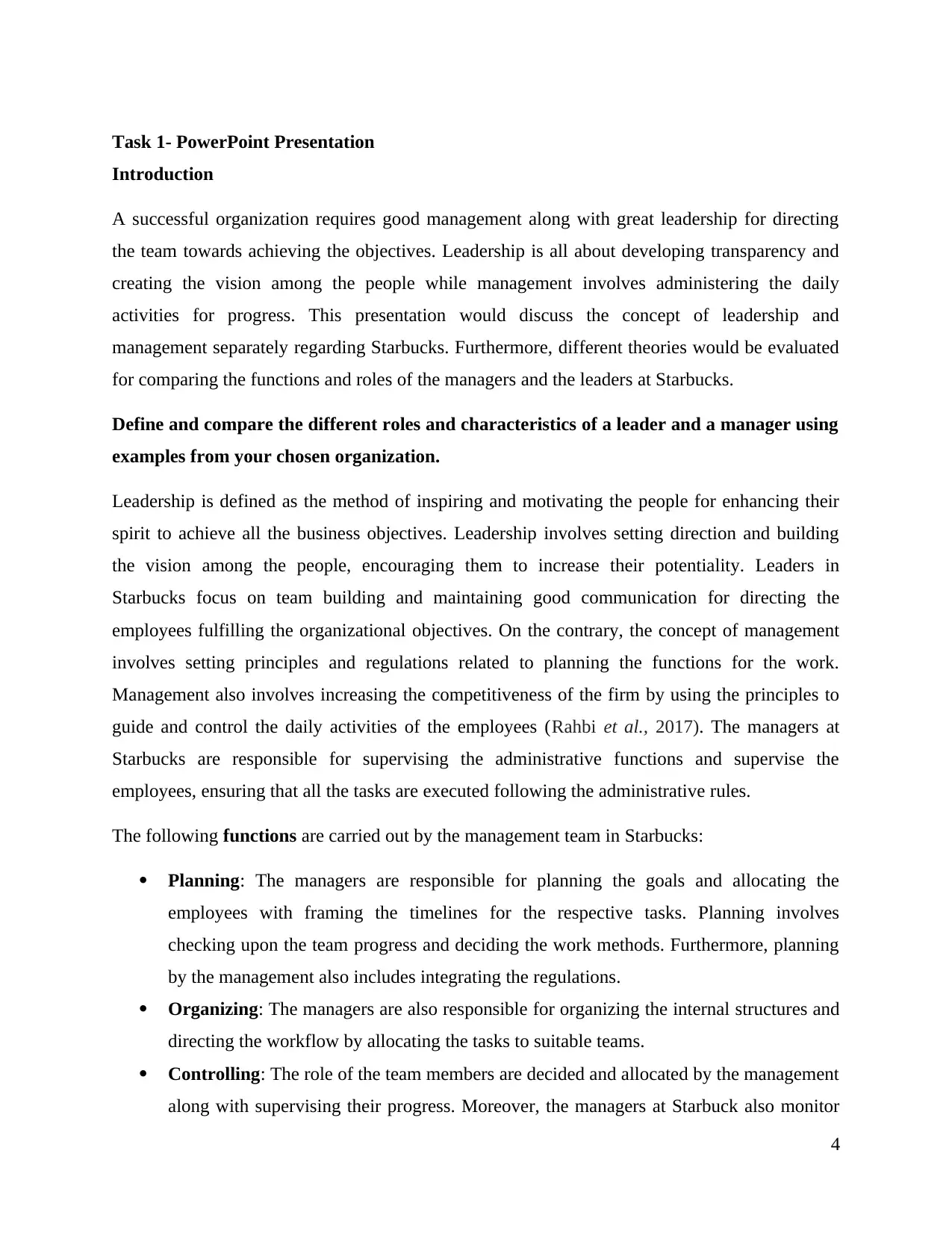
Task 1- PowerPoint Presentation
Introduction
A successful organization requires good management along with great leadership for directing
the team towards achieving the objectives. Leadership is all about developing transparency and
creating the vision among the people while management involves administering the daily
activities for progress. This presentation would discuss the concept of leadership and
management separately regarding Starbucks. Furthermore, different theories would be evaluated
for comparing the functions and roles of the managers and the leaders at Starbucks.
Define and compare the different roles and characteristics of a leader and a manager using
examples from your chosen organization.
Leadership is defined as the method of inspiring and motivating the people for enhancing their
spirit to achieve all the business objectives. Leadership involves setting direction and building
the vision among the people, encouraging them to increase their potentiality. Leaders in
Starbucks focus on team building and maintaining good communication for directing the
employees fulfilling the organizational objectives. On the contrary, the concept of management
involves setting principles and regulations related to planning the functions for the work.
Management also involves increasing the competitiveness of the firm by using the principles to
guide and control the daily activities of the employees (Rahbi et al., 2017). The managers at
Starbucks are responsible for supervising the administrative functions and supervise the
employees, ensuring that all the tasks are executed following the administrative rules.
The following functions are carried out by the management team in Starbucks:
Planning: The managers are responsible for planning the goals and allocating the
employees with framing the timelines for the respective tasks. Planning involves
checking upon the team progress and deciding the work methods. Furthermore, planning
by the management also includes integrating the regulations.
Organizing: The managers are also responsible for organizing the internal structures and
directing the workflow by allocating the tasks to suitable teams.
Controlling: The role of the team members are decided and allocated by the management
along with supervising their progress. Moreover, the managers at Starbuck also monitor
4
Introduction
A successful organization requires good management along with great leadership for directing
the team towards achieving the objectives. Leadership is all about developing transparency and
creating the vision among the people while management involves administering the daily
activities for progress. This presentation would discuss the concept of leadership and
management separately regarding Starbucks. Furthermore, different theories would be evaluated
for comparing the functions and roles of the managers and the leaders at Starbucks.
Define and compare the different roles and characteristics of a leader and a manager using
examples from your chosen organization.
Leadership is defined as the method of inspiring and motivating the people for enhancing their
spirit to achieve all the business objectives. Leadership involves setting direction and building
the vision among the people, encouraging them to increase their potentiality. Leaders in
Starbucks focus on team building and maintaining good communication for directing the
employees fulfilling the organizational objectives. On the contrary, the concept of management
involves setting principles and regulations related to planning the functions for the work.
Management also involves increasing the competitiveness of the firm by using the principles to
guide and control the daily activities of the employees (Rahbi et al., 2017). The managers at
Starbucks are responsible for supervising the administrative functions and supervise the
employees, ensuring that all the tasks are executed following the administrative rules.
The following functions are carried out by the management team in Starbucks:
Planning: The managers are responsible for planning the goals and allocating the
employees with framing the timelines for the respective tasks. Planning involves
checking upon the team progress and deciding the work methods. Furthermore, planning
by the management also includes integrating the regulations.
Organizing: The managers are also responsible for organizing the internal structures and
directing the workflow by allocating the tasks to suitable teams.
Controlling: The role of the team members are decided and allocated by the management
along with supervising their progress. Moreover, the managers at Starbuck also monitor
4
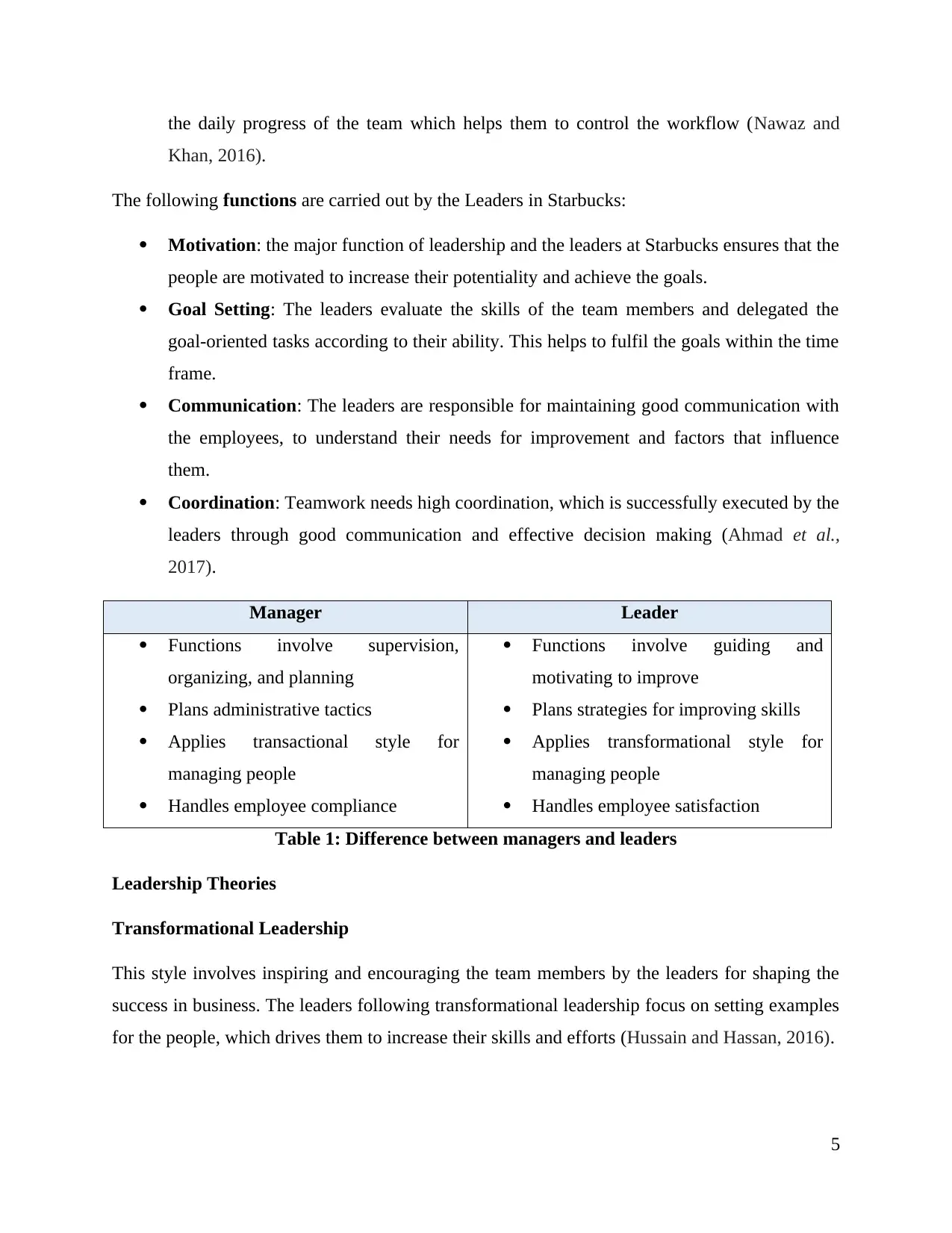
the daily progress of the team which helps them to control the workflow (Nawaz and
Khan, 2016).
The following functions are carried out by the Leaders in Starbucks:
Motivation: the major function of leadership and the leaders at Starbucks ensures that the
people are motivated to increase their potentiality and achieve the goals.
Goal Setting: The leaders evaluate the skills of the team members and delegated the
goal-oriented tasks according to their ability. This helps to fulfil the goals within the time
frame.
Communication: The leaders are responsible for maintaining good communication with
the employees, to understand their needs for improvement and factors that influence
them.
Coordination: Teamwork needs high coordination, which is successfully executed by the
leaders through good communication and effective decision making (Ahmad et al.,
2017).
Manager Leader
Functions involve supervision,
organizing, and planning
Plans administrative tactics
Applies transactional style for
managing people
Handles employee compliance
Functions involve guiding and
motivating to improve
Plans strategies for improving skills
Applies transformational style for
managing people
Handles employee satisfaction
Table 1: Difference between managers and leaders
Leadership Theories
Transformational Leadership
This style involves inspiring and encouraging the team members by the leaders for shaping the
success in business. The leaders following transformational leadership focus on setting examples
for the people, which drives them to increase their skills and efforts (Hussain and Hassan, 2016).
5
Khan, 2016).
The following functions are carried out by the Leaders in Starbucks:
Motivation: the major function of leadership and the leaders at Starbucks ensures that the
people are motivated to increase their potentiality and achieve the goals.
Goal Setting: The leaders evaluate the skills of the team members and delegated the
goal-oriented tasks according to their ability. This helps to fulfil the goals within the time
frame.
Communication: The leaders are responsible for maintaining good communication with
the employees, to understand their needs for improvement and factors that influence
them.
Coordination: Teamwork needs high coordination, which is successfully executed by the
leaders through good communication and effective decision making (Ahmad et al.,
2017).
Manager Leader
Functions involve supervision,
organizing, and planning
Plans administrative tactics
Applies transactional style for
managing people
Handles employee compliance
Functions involve guiding and
motivating to improve
Plans strategies for improving skills
Applies transformational style for
managing people
Handles employee satisfaction
Table 1: Difference between managers and leaders
Leadership Theories
Transformational Leadership
This style involves inspiring and encouraging the team members by the leaders for shaping the
success in business. The leaders following transformational leadership focus on setting examples
for the people, which drives them to increase their skills and efforts (Hussain and Hassan, 2016).
5
⊘ This is a preview!⊘
Do you want full access?
Subscribe today to unlock all pages.

Trusted by 1+ million students worldwide
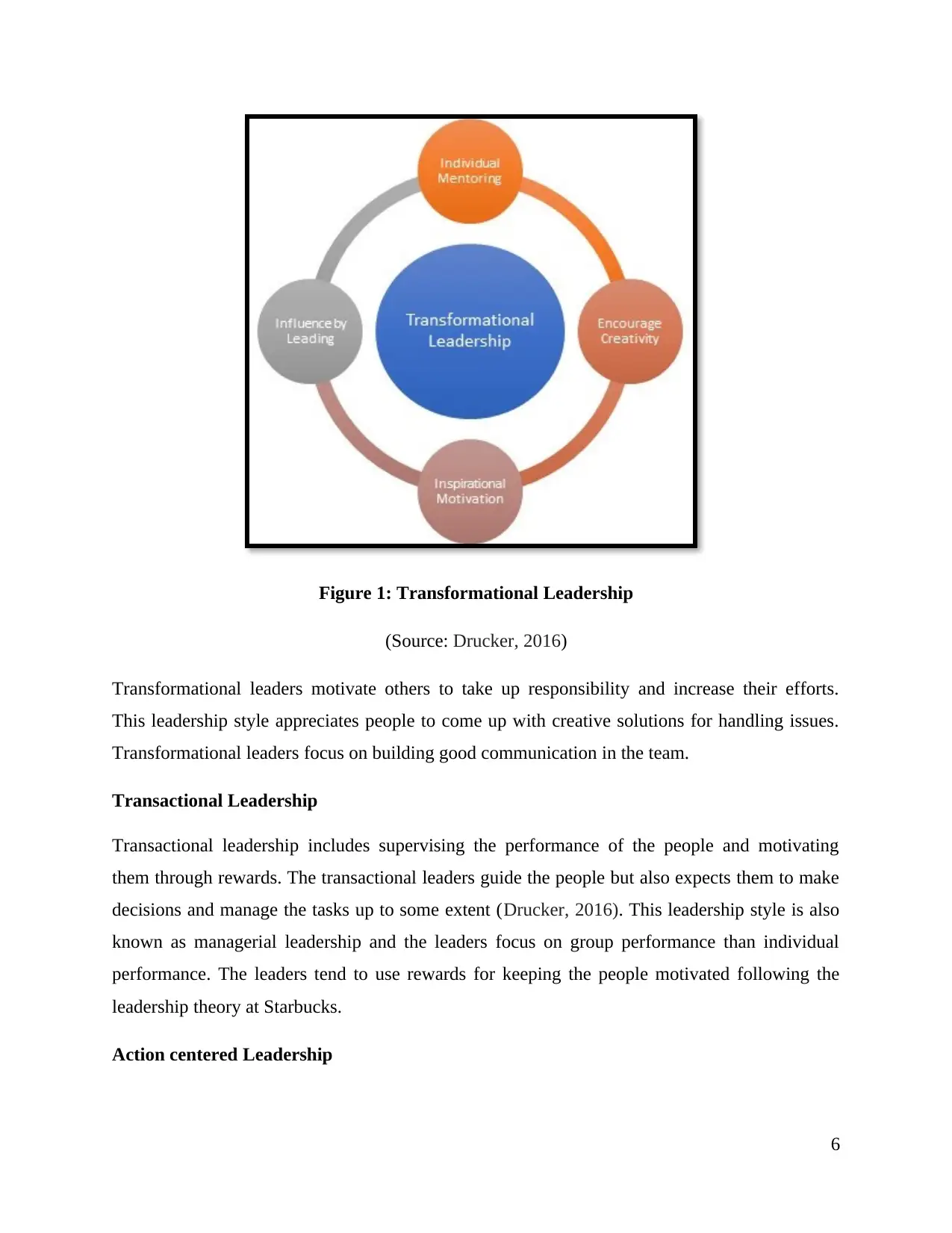
Figure 1: Transformational Leadership
(Source: Drucker, 2016)
Transformational leaders motivate others to take up responsibility and increase their efforts.
This leadership style appreciates people to come up with creative solutions for handling issues.
Transformational leaders focus on building good communication in the team.
Transactional Leadership
Transactional leadership includes supervising the performance of the people and motivating
them through rewards. The transactional leaders guide the people but also expects them to make
decisions and manage the tasks up to some extent (Drucker, 2016). This leadership style is also
known as managerial leadership and the leaders focus on group performance than individual
performance. The leaders tend to use rewards for keeping the people motivated following the
leadership theory at Starbucks.
Action centered Leadership
6
(Source: Drucker, 2016)
Transformational leaders motivate others to take up responsibility and increase their efforts.
This leadership style appreciates people to come up with creative solutions for handling issues.
Transformational leaders focus on building good communication in the team.
Transactional Leadership
Transactional leadership includes supervising the performance of the people and motivating
them through rewards. The transactional leaders guide the people but also expects them to make
decisions and manage the tasks up to some extent (Drucker, 2016). This leadership style is also
known as managerial leadership and the leaders focus on group performance than individual
performance. The leaders tend to use rewards for keeping the people motivated following the
leadership theory at Starbucks.
Action centered Leadership
6
Paraphrase This Document
Need a fresh take? Get an instant paraphrase of this document with our AI Paraphraser
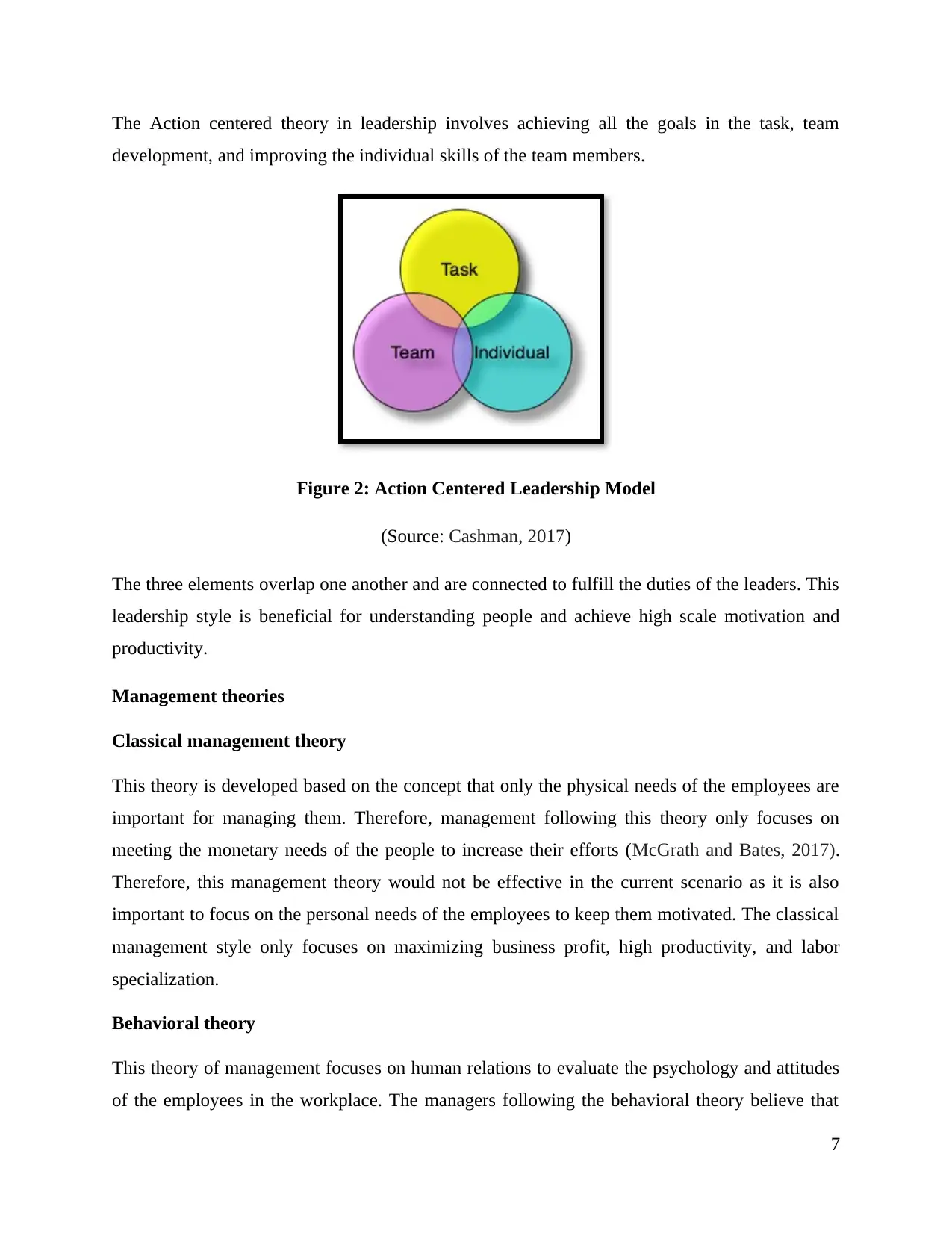
The Action centered theory in leadership involves achieving all the goals in the task, team
development, and improving the individual skills of the team members.
Figure 2: Action Centered Leadership Model
(Source: Cashman, 2017)
The three elements overlap one another and are connected to fulfill the duties of the leaders. This
leadership style is beneficial for understanding people and achieve high scale motivation and
productivity.
Management theories
Classical management theory
This theory is developed based on the concept that only the physical needs of the employees are
important for managing them. Therefore, management following this theory only focuses on
meeting the monetary needs of the people to increase their efforts (McGrath and Bates, 2017).
Therefore, this management theory would not be effective in the current scenario as it is also
important to focus on the personal needs of the employees to keep them motivated. The classical
management style only focuses on maximizing business profit, high productivity, and labor
specialization.
Behavioral theory
This theory of management focuses on human relations to evaluate the psychology and attitudes
of the employees in the workplace. The managers following the behavioral theory believe that
7
development, and improving the individual skills of the team members.
Figure 2: Action Centered Leadership Model
(Source: Cashman, 2017)
The three elements overlap one another and are connected to fulfill the duties of the leaders. This
leadership style is beneficial for understanding people and achieve high scale motivation and
productivity.
Management theories
Classical management theory
This theory is developed based on the concept that only the physical needs of the employees are
important for managing them. Therefore, management following this theory only focuses on
meeting the monetary needs of the people to increase their efforts (McGrath and Bates, 2017).
Therefore, this management theory would not be effective in the current scenario as it is also
important to focus on the personal needs of the employees to keep them motivated. The classical
management style only focuses on maximizing business profit, high productivity, and labor
specialization.
Behavioral theory
This theory of management focuses on human relations to evaluate the psychology and attitudes
of the employees in the workplace. The managers following the behavioral theory believe that
7
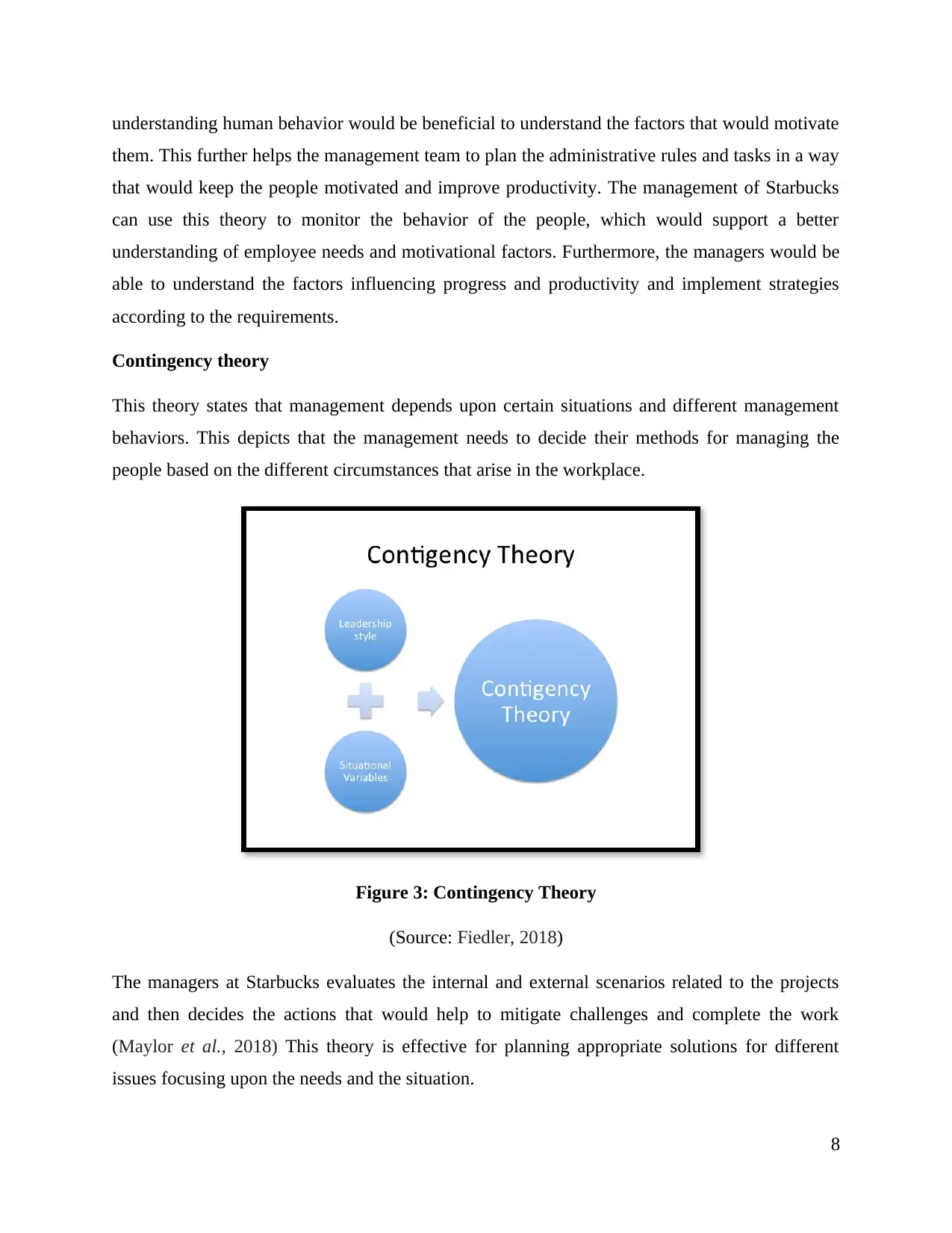
understanding human behavior would be beneficial to understand the factors that would motivate
them. This further helps the management team to plan the administrative rules and tasks in a way
that would keep the people motivated and improve productivity. The management of Starbucks
can use this theory to monitor the behavior of the people, which would support a better
understanding of employee needs and motivational factors. Furthermore, the managers would be
able to understand the factors influencing progress and productivity and implement strategies
according to the requirements.
Contingency theory
This theory states that management depends upon certain situations and different management
behaviors. This depicts that the management needs to decide their methods for managing the
people based on the different circumstances that arise in the workplace.
Figure 3: Contingency Theory
(Source: Fiedler, 2018)
The managers at Starbucks evaluates the internal and external scenarios related to the projects
and then decides the actions that would help to mitigate challenges and complete the work
(Maylor et al., 2018) This theory is effective for planning appropriate solutions for different
issues focusing upon the needs and the situation.
8
them. This further helps the management team to plan the administrative rules and tasks in a way
that would keep the people motivated and improve productivity. The management of Starbucks
can use this theory to monitor the behavior of the people, which would support a better
understanding of employee needs and motivational factors. Furthermore, the managers would be
able to understand the factors influencing progress and productivity and implement strategies
according to the requirements.
Contingency theory
This theory states that management depends upon certain situations and different management
behaviors. This depicts that the management needs to decide their methods for managing the
people based on the different circumstances that arise in the workplace.
Figure 3: Contingency Theory
(Source: Fiedler, 2018)
The managers at Starbucks evaluates the internal and external scenarios related to the projects
and then decides the actions that would help to mitigate challenges and complete the work
(Maylor et al., 2018) This theory is effective for planning appropriate solutions for different
issues focusing upon the needs and the situation.
8
⊘ This is a preview!⊘
Do you want full access?
Subscribe today to unlock all pages.

Trusted by 1+ million students worldwide
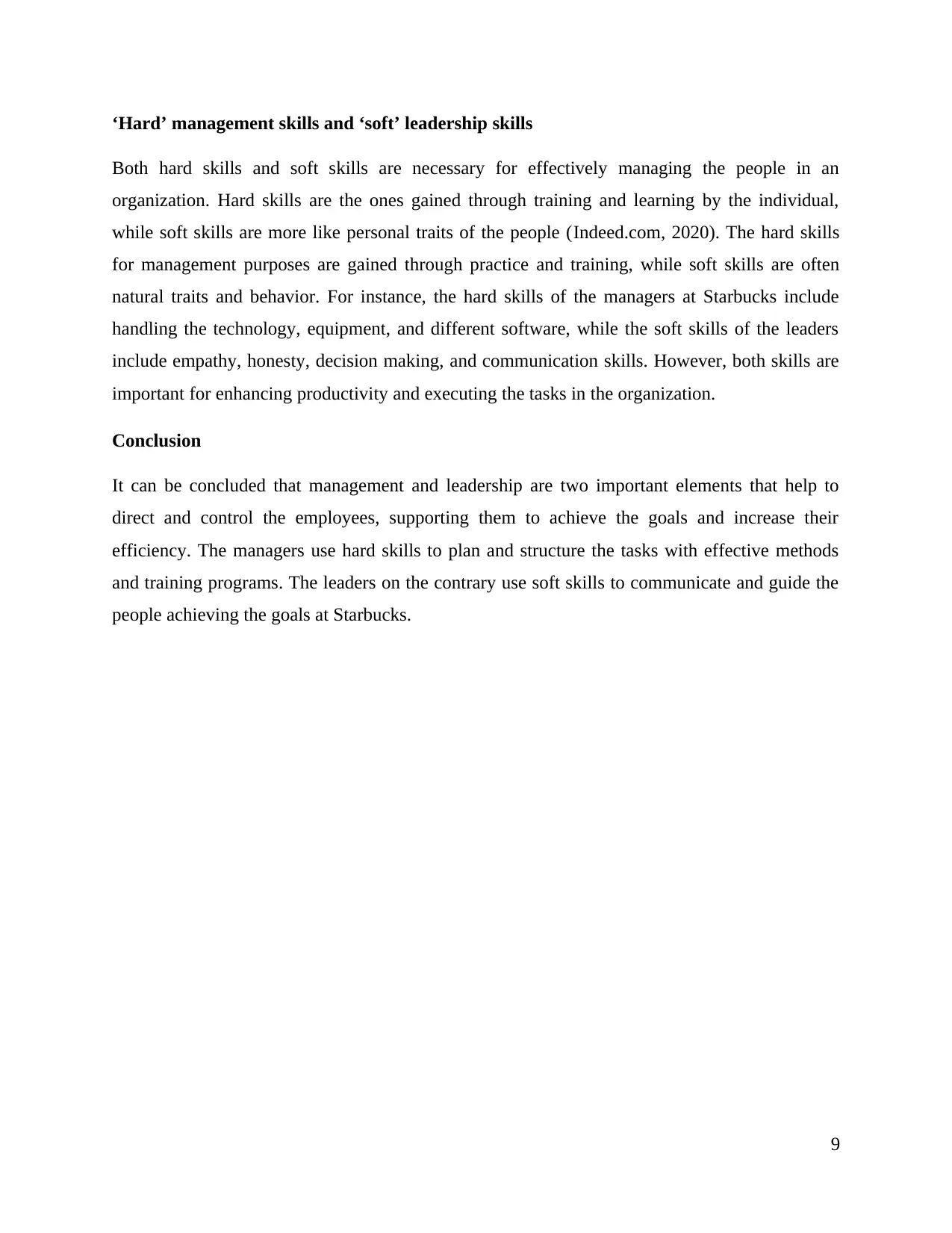
‘Hard’ management skills and ‘soft’ leadership skills
Both hard skills and soft skills are necessary for effectively managing the people in an
organization. Hard skills are the ones gained through training and learning by the individual,
while soft skills are more like personal traits of the people (Indeed.com, 2020). The hard skills
for management purposes are gained through practice and training, while soft skills are often
natural traits and behavior. For instance, the hard skills of the managers at Starbucks include
handling the technology, equipment, and different software, while the soft skills of the leaders
include empathy, honesty, decision making, and communication skills. However, both skills are
important for enhancing productivity and executing the tasks in the organization.
Conclusion
It can be concluded that management and leadership are two important elements that help to
direct and control the employees, supporting them to achieve the goals and increase their
efficiency. The managers use hard skills to plan and structure the tasks with effective methods
and training programs. The leaders on the contrary use soft skills to communicate and guide the
people achieving the goals at Starbucks.
9
Both hard skills and soft skills are necessary for effectively managing the people in an
organization. Hard skills are the ones gained through training and learning by the individual,
while soft skills are more like personal traits of the people (Indeed.com, 2020). The hard skills
for management purposes are gained through practice and training, while soft skills are often
natural traits and behavior. For instance, the hard skills of the managers at Starbucks include
handling the technology, equipment, and different software, while the soft skills of the leaders
include empathy, honesty, decision making, and communication skills. However, both skills are
important for enhancing productivity and executing the tasks in the organization.
Conclusion
It can be concluded that management and leadership are two important elements that help to
direct and control the employees, supporting them to achieve the goals and increase their
efficiency. The managers use hard skills to plan and structure the tasks with effective methods
and training programs. The leaders on the contrary use soft skills to communicate and guide the
people achieving the goals at Starbucks.
9
Paraphrase This Document
Need a fresh take? Get an instant paraphrase of this document with our AI Paraphraser
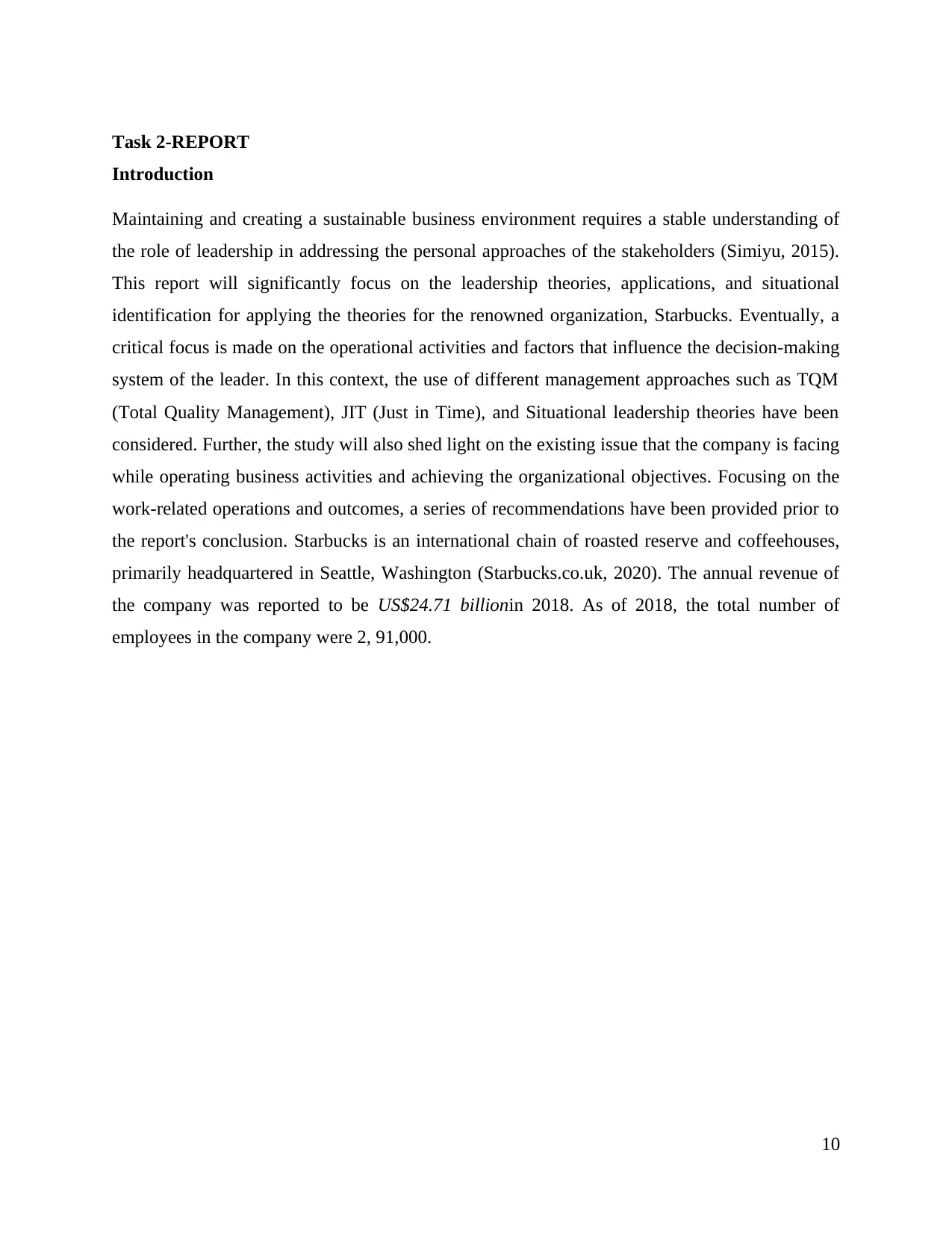
Task 2-REPORT
Introduction
Maintaining and creating a sustainable business environment requires a stable understanding of
the role of leadership in addressing the personal approaches of the stakeholders (Simiyu, 2015).
This report will significantly focus on the leadership theories, applications, and situational
identification for applying the theories for the renowned organization, Starbucks. Eventually, a
critical focus is made on the operational activities and factors that influence the decision-making
system of the leader. In this context, the use of different management approaches such as TQM
(Total Quality Management), JIT (Just in Time), and Situational leadership theories have been
considered. Further, the study will also shed light on the existing issue that the company is facing
while operating business activities and achieving the organizational objectives. Focusing on the
work-related operations and outcomes, a series of recommendations have been provided prior to
the report's conclusion. Starbucks is an international chain of roasted reserve and coffeehouses,
primarily headquartered in Seattle, Washington (Starbucks.co.uk, 2020). The annual revenue of
the company was reported to be US$24.71 billionin 2018. As of 2018, the total number of
employees in the company were 2, 91,000.
10
Introduction
Maintaining and creating a sustainable business environment requires a stable understanding of
the role of leadership in addressing the personal approaches of the stakeholders (Simiyu, 2015).
This report will significantly focus on the leadership theories, applications, and situational
identification for applying the theories for the renowned organization, Starbucks. Eventually, a
critical focus is made on the operational activities and factors that influence the decision-making
system of the leader. In this context, the use of different management approaches such as TQM
(Total Quality Management), JIT (Just in Time), and Situational leadership theories have been
considered. Further, the study will also shed light on the existing issue that the company is facing
while operating business activities and achieving the organizational objectives. Focusing on the
work-related operations and outcomes, a series of recommendations have been provided prior to
the report's conclusion. Starbucks is an international chain of roasted reserve and coffeehouses,
primarily headquartered in Seattle, Washington (Starbucks.co.uk, 2020). The annual revenue of
the company was reported to be US$24.71 billionin 2018. As of 2018, the total number of
employees in the company were 2, 91,000.
10
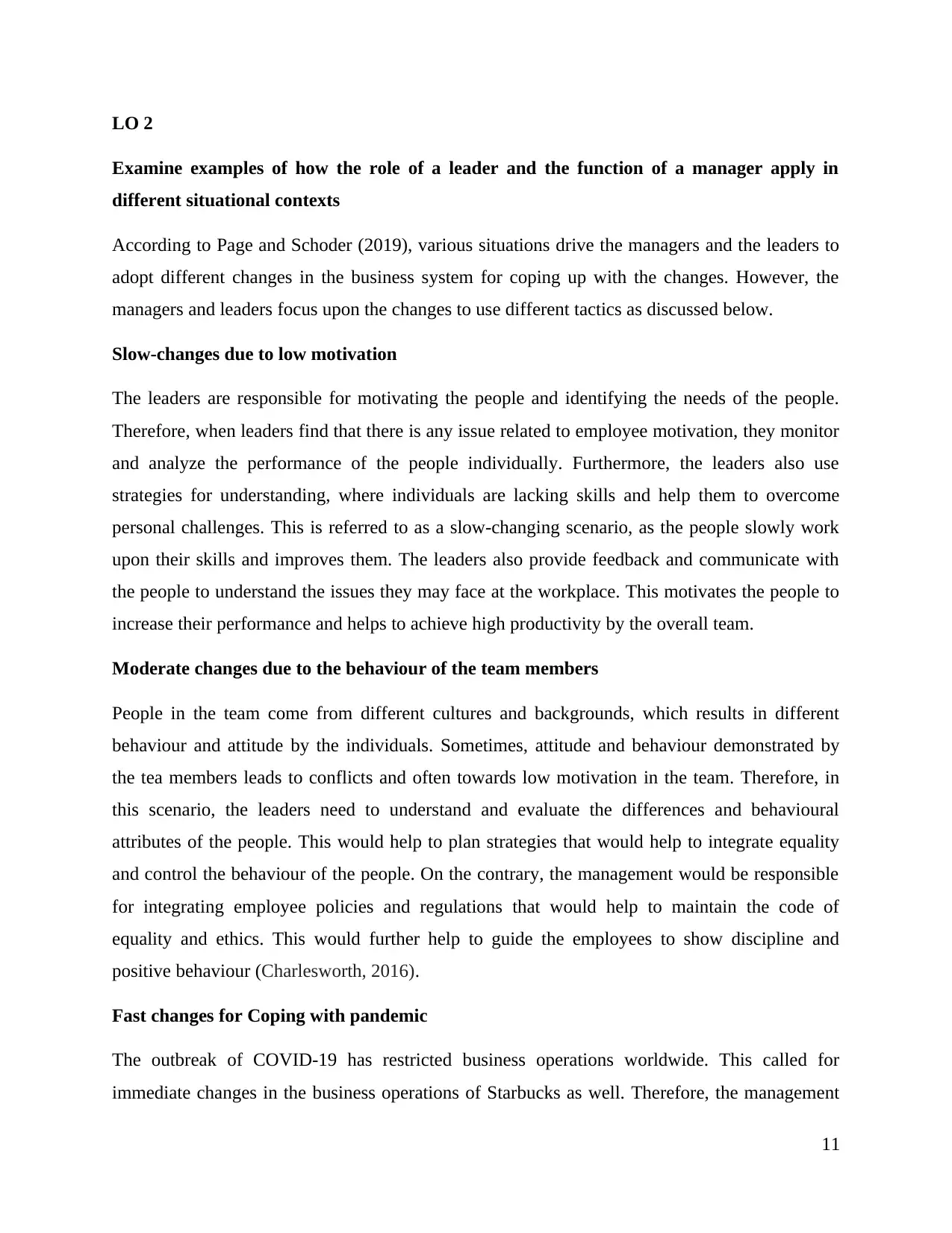
LO 2
Examine examples of how the role of a leader and the function of a manager apply in
different situational contexts
According to Page and Schoder (2019), various situations drive the managers and the leaders to
adopt different changes in the business system for coping up with the changes. However, the
managers and leaders focus upon the changes to use different tactics as discussed below.
Slow-changes due to low motivation
The leaders are responsible for motivating the people and identifying the needs of the people.
Therefore, when leaders find that there is any issue related to employee motivation, they monitor
and analyze the performance of the people individually. Furthermore, the leaders also use
strategies for understanding, where individuals are lacking skills and help them to overcome
personal challenges. This is referred to as a slow-changing scenario, as the people slowly work
upon their skills and improves them. The leaders also provide feedback and communicate with
the people to understand the issues they may face at the workplace. This motivates the people to
increase their performance and helps to achieve high productivity by the overall team.
Moderate changes due to the behaviour of the team members
People in the team come from different cultures and backgrounds, which results in different
behaviour and attitude by the individuals. Sometimes, attitude and behaviour demonstrated by
the tea members leads to conflicts and often towards low motivation in the team. Therefore, in
this scenario, the leaders need to understand and evaluate the differences and behavioural
attributes of the people. This would help to plan strategies that would help to integrate equality
and control the behaviour of the people. On the contrary, the management would be responsible
for integrating employee policies and regulations that would help to maintain the code of
equality and ethics. This would further help to guide the employees to show discipline and
positive behaviour (Charlesworth, 2016).
Fast changes for Coping with pandemic
The outbreak of COVID-19 has restricted business operations worldwide. This called for
immediate changes in the business operations of Starbucks as well. Therefore, the management
11
Examine examples of how the role of a leader and the function of a manager apply in
different situational contexts
According to Page and Schoder (2019), various situations drive the managers and the leaders to
adopt different changes in the business system for coping up with the changes. However, the
managers and leaders focus upon the changes to use different tactics as discussed below.
Slow-changes due to low motivation
The leaders are responsible for motivating the people and identifying the needs of the people.
Therefore, when leaders find that there is any issue related to employee motivation, they monitor
and analyze the performance of the people individually. Furthermore, the leaders also use
strategies for understanding, where individuals are lacking skills and help them to overcome
personal challenges. This is referred to as a slow-changing scenario, as the people slowly work
upon their skills and improves them. The leaders also provide feedback and communicate with
the people to understand the issues they may face at the workplace. This motivates the people to
increase their performance and helps to achieve high productivity by the overall team.
Moderate changes due to the behaviour of the team members
People in the team come from different cultures and backgrounds, which results in different
behaviour and attitude by the individuals. Sometimes, attitude and behaviour demonstrated by
the tea members leads to conflicts and often towards low motivation in the team. Therefore, in
this scenario, the leaders need to understand and evaluate the differences and behavioural
attributes of the people. This would help to plan strategies that would help to integrate equality
and control the behaviour of the people. On the contrary, the management would be responsible
for integrating employee policies and regulations that would help to maintain the code of
equality and ethics. This would further help to guide the employees to show discipline and
positive behaviour (Charlesworth, 2016).
Fast changes for Coping with pandemic
The outbreak of COVID-19 has restricted business operations worldwide. This called for
immediate changes in the business operations of Starbucks as well. Therefore, the management
11
⊘ This is a preview!⊘
Do you want full access?
Subscribe today to unlock all pages.

Trusted by 1+ million students worldwide
1 out of 39
Related Documents
Your All-in-One AI-Powered Toolkit for Academic Success.
+13062052269
info@desklib.com
Available 24*7 on WhatsApp / Email
![[object Object]](/_next/static/media/star-bottom.7253800d.svg)
Unlock your academic potential
Copyright © 2020–2025 A2Z Services. All Rights Reserved. Developed and managed by ZUCOL.





